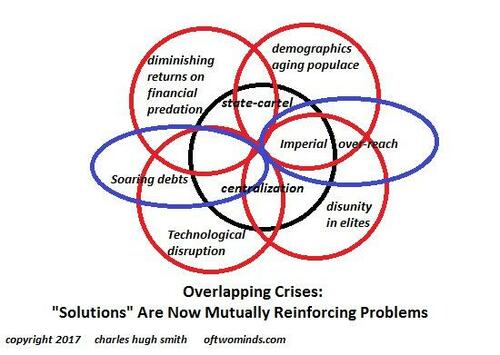These Four Themes Will Define The Next Decade
Authored by Charles Hugh Smith via Substack,
Morgan Stanley recently came out with their 3 Themes that will impact markets for many years: longevity, AI tech diffusion, and decarbonization, i.e. the transition from hydrocarbon fuels to so-called “green energy.”
That’s the status quo: everything’s great! Pills that cost $1,000 a month will make us live longer, AI will increase corporate profits (which is the entire point of the economy, of course) and those who invest in the “green energy” transition will be rewarded with fabulous wealth.
That all sounds peachy, but the real world will be defined by four much different themes: sclerosis, dysfunction, debt saturation and power asymmetry.
1. Sclerosis: the same old nodes of power cling onto power and so nothing changes because nothing can change: those in power must maintain or expand their power, regardless of what comes along, and that sclerosis is the systemic problem that cannot be resolved.
2. Dysfunction: nothing works due to the consequences of sclerosis: those who cling to power do so by eliminating every dynamic of open, self-correcting systems: they get rid of competition (every sector is dominated by monopolies, cartels or state-cartels), they get rid of transparency (information asymmetry is how they maintain power) and they have a lock on regulatory complexity / capture: first jump through all these hoops and maybe we’ll let you propose some worthless policy tweak that leaves our power intact. Or we’ll co-opt you by inviting you to become one of our flunkies, PR flacks, factotums, enforcers, lackeys, etc.
In a system rigged to maximize the profit and power of the few at the expense of the many, nothing works because the system is no longer capable of self-correction.
3. Debt saturation: 15 years of expanding credit has created the illusion we can pay for everything, no matter how costly, from future earnings, basically forever. So we need trillions to transition to “green energy,” no problem, we’ll borrow it. We need more trillions to pay for an aging, increasingly sickly populace, no problem, we’ll borrow it. We need to borrow more trillions to fund all the status quo grift and graft, no problem, we’ll borrow it.
And since we can pin interest rates to zero forever, we can borrow whatever tiny sums we need to pay the interest on hundreds of trillions in new debt, no problem. Except for one little dynamic called debt saturation: future earnings are not guaranteed, and at some point the income cannot sustain both the eternally expanding consumer and state spending needed to keep the Waste Is Growth Landfill Economy from imploding and the rising debt service on the ballooning debt.
We can afford only one: either borrow and spend to keep the Waste Is Growth Landfill Economy humming, or we can devote that income to servicing rising debt. We can’t do both, so one or the other will collapse: either consumer/state borrowing and spending or the Palace of Debt.
This reality increases risk, and capital eventually demands a real return. Interest rates can’t stay at zero, so the costs of servicing the soaring debt rises rapidly. At the same time, the immense expansion of credit–money borrowed from future income to be spent today–generates inflation, as the flood of credit needed to keep a sclerotic, dysfunctional status quo afloat outpaces the value being generated by all the trillions being borrowed and blown.
No one at the trough of “free money” will give up their place, and so the system is rigged to fail: we have to keep borrowing trillions to keep all the incumbents, entrenched interests and those collecting benefits happy, but as interest payments rise, we need to borrow more trillions just to pay the interest. And so on, in a self-reinforcing feedback loop.
4. Power asymmetry is my term for the structural inequality and bondage that characterize the global status quo. The many have very little power over anything, while the few hoard the power to make sure they keep what they have and to protect their perquisites from competing elites and populist movements. Debt serfdom is a good example of bondage–you need to borrow to live–and power asymmetry: debt-serfs have essentially zero power in the economy, society or the sclerotic systems of governance.
No amount of AI or new technology will change any of this, because all those tools serve those already in power. In effect, AI and all other new technologies simply serve to solidify power asymmetry and thus sclerosis and dysfunction. And since the system demands “free money” borrowed from the future to keep everyone at the trough happy, it also guarantees debt saturation, which eventually triggers a phase change much like liquid water (liquidity) suddenly freezing into ice.
Everyone at the trough believes that the transition from liquid water (free flowing credit) to ice cannot possibly happen. So when it happens, everyone will be surprised. What do you mean, there are limits?
New podcast Vision Series: AI Job Challenges and Trends (34:54 min)
Tyler Durden
Mon, 03/04/2024 – 22:20
via ZeroHedge News https://ift.tt/HoC3nrS Tyler Durden
